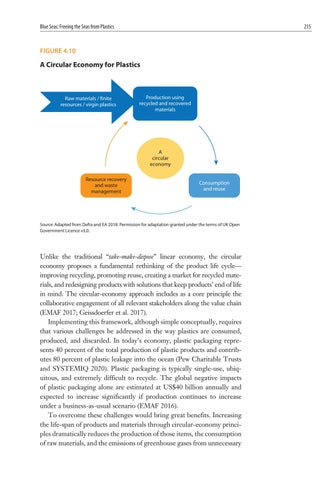Blue Seas: Freeing the Seas from Plastics
215
FIGURE 4.10
A Circular Economy for Plastics
Raw materials / finite resources / virgin plastics
Production using recycled and recovered materials
A circular economy Resource recovery and waste management
Consumption and reuse
Source: Adapted from Defra and EA 2018. Permission for adaptation granted under the terms of UK Open Government Licence v3.0.
Unlike the traditional “take-make-dispose” linear economy, the circular economy proposes a fundamental rethinking of the product life cycle— improving recycling, promoting reuse, creating a market for recycled materials, and redesigning products with solutions that keep products’ end of life in mind. The circular-economy approach includes as a core principle the collaborative engagement of all relevant stakeholders along the value chain (EMAF 2017; Geissdoerfer et al. 2017). Implementing this framework, although simple conceptually, requires that various challenges be addressed in the way plastics are consumed, produced, and discarded. In today’s economy, plastic packaging represents 40 percent of the total production of plastic products and contributes 80 percent of plastic leakage into the ocean (Pew Charitable Trusts and SYSTEMIQ 2020). Plastic packaging is typically single-use, ubiquitous, and extremely difficult to recycle. The global negative impacts of plastic packaging alone are estimated at US$40 billion annually and expected to increase significantly if production continues to increase under a business-as-usual scenario (EMAF 2016). To overcome these challenges would bring great benefits. Increasing the life-span of products and materials through circular-economy principles dramatically reduces the production of those items, the consumption of raw materials, and the emissions of greenhouse gases from unnecessary






